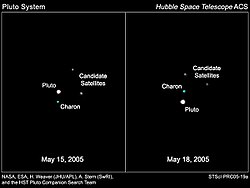Hydra (måne)
| Hydra | |
 Vy från Hydra eller Nix (konstnärs tolkning). | |
| Upptäckt | |
|---|---|
| Upptäckare | Rymdteleskopet Hubble Pluto Companion Search Team |
| Upptäcktsdatum | Juni, 2005 |
| Beteckningar | |
| Alternativnamn | S/2005 P 1 |
| Uppkallad efter | Hydra |
| Omloppsbana | |
| Måne till | Pluto |
| Fysikaliska data | |
| Dimensioner | 45 km × 32 km[1] |
| Hitta fler artiklar om astronomi med | |
Hydra (S/2005 P1) är en av Plutos fem kända månar[2][3]. Den upptäcktes med Rymdteleskopet Hubble[4] av Pluto Companion Search Team i juni 2005. Pluto Companion Search Team består av Hal A. Weaver, S. Alan Stern, Max J. Mutchler, Andrew J. Steffl, Marc W. Buie, William J. Merline, John R. Spencer, Eliot F. Young, och Leslie A. Young. Vid samma tillfälle upptäcktes Plutos måne Nix.
Upptäckarbilderna togs den 15 maj och 18 maj 2005. Månen sågs för första gången av Max J. Mutchler den 15 juni samma år. Man tillkännagav upptäckten, när man hade bekräftat att månen fanns där, den 31 oktober 2005.[källa behövs]
Hydra är ungefär 45 km × 32 km stor och oregelbunden. Den reflekterar 45 procent av ljuset som når den, varför den sannolikt är täckt av is.[1]
När New Horizons passerade den i juli 2015 konstaterades det att det finns fruset vatten på Hydra.[5]


Noter
- ^ [a b] Pluto-ohituksen lehdistötilaisuus hetki hetkeltä, Ursa, 15 juli 2015
- ^ ”Första närkontakten med Pluto närmar sig”. 14 juni 2015. http://www.dn.se/nyheter/vetenskap/forsta-narkontakten-med-pluto-narmar-sig/. Läst 10 juli 2015.
- ^ ”Första mötet med Pluto”. Arkiverad från originalet den 11 juli 2015. https://web.archive.org/web/20150711100825/http://hbl.fi/nyheter/2015-06-23/760231/forsta-motet-med-pluto. Läst 10 juli 2015.
- ^ ”Plutos månar skummare än förväntat”. Arkiverad från originalet den 11 juli 2015. https://web.archive.org/web/20150711122051/http://klaraskyar.se/2015/06/06/plutos-manar-skummare-an-forvantat/. Läst 10 juli 2015.
- ^ ”Hydra Emerges from the Shadows”. http://www.nasa.gov/image-feature/hydra-emerges-from-the-shadows. Läst 15 juli 2015.
| ||||||||||||||||||||
Media som används på denna webbplats
Discovery images of Plutonian satellites P1 and P2. "The enhanced-color images of Pluto (the brightest object) and Charon (to the right of Pluto) were constructed by combining short exposure images taken in filters near 475 nanometers (blue) and 555 nanometers (green-yellow). The images of the new satellites were made from longer exposures taken in a single filter centered near 606 nanometers (yellow), so no color information is available for them."
PLUTO - NEW HORIZONS - July 14, 2015
ORIGINAL IMAGE DESCRIPTION:
Four images from New Horizons’ Long Range Reconnaissance Imager (LORRI) were combined with color data from the Ralph instrument to create this global view of Pluto. (The lower right edge of Pluto in this view currently lacks high-resolution color coverage.) The images, taken when the spacecraft was 280,000 miles (450,000 kilometers) away, show features as small as 1.4 miles (2.2 kilometers), twice the resolution of the single-image view taken on July 13 [2015].
UPLOADER NOTES:
The north polar region is at top, with bright Tombaugh Regio to the lower right of center and part of the dark Cthulhu Regio at lower left. Part of the dark Krun Regio is also visible at extreme lower right.
The original NASA image has been modified by doubling the linear pixel density and cropping.Hydra imaged by the LORRI instrument aboard the New Horizons spacecraft on 14 July.
The image shows a view from from the surface of one of the moons of Pluto. Plus is the large disk at center, Charon is the medium-sized object to the right of Pluto, and an additional moon is the bright dot to the far left of Pluto. The remaining two known moons are not (intentionally) depicted.




